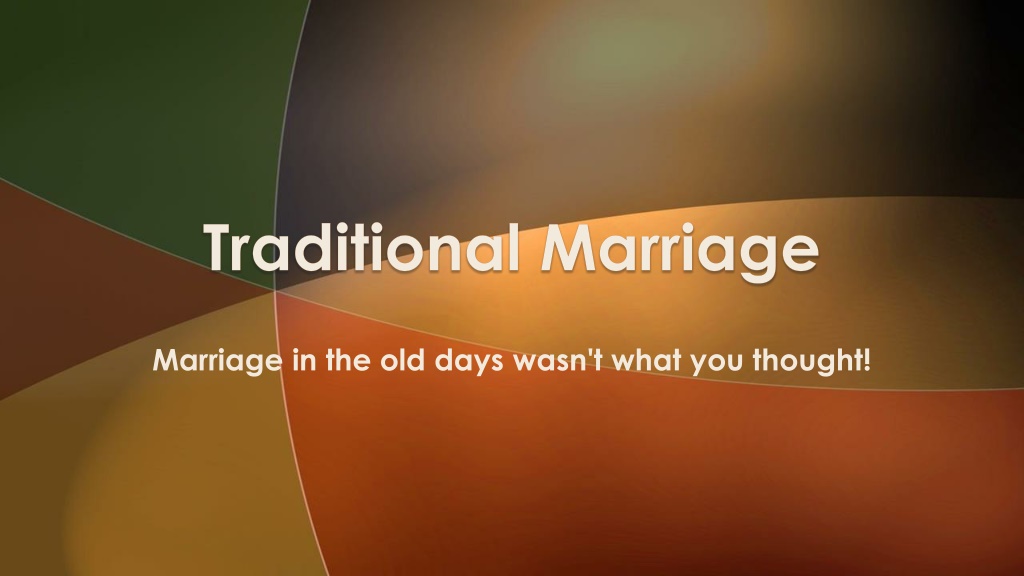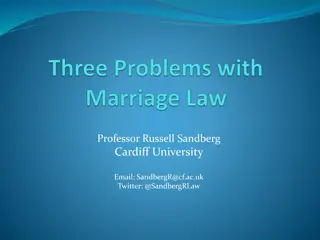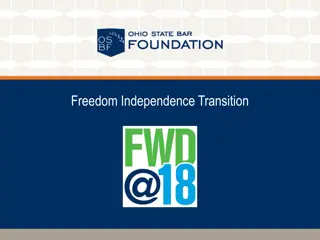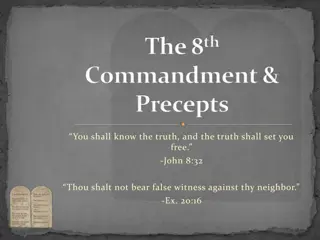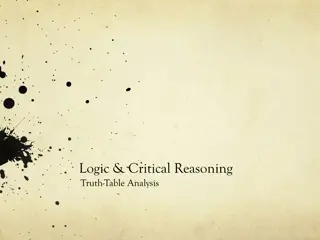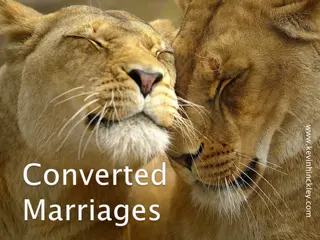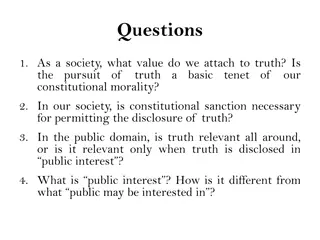The Truth About Traditional Marriage in History
Marriage in ancient times was far from the romanticized notion we have today. Love was not a factor, marriages were often arranged for various reasons, and happiness was not a priority. This article delves into the history of traditional marriage, shedding light on the realities our ancestors faced.
Download Presentation

Please find below an Image/Link to download the presentation.
The content on the website is provided AS IS for your information and personal use only. It may not be sold, licensed, or shared on other websites without obtaining consent from the author.If you encounter any issues during the download, it is possible that the publisher has removed the file from their server.
You are allowed to download the files provided on this website for personal or commercial use, subject to the condition that they are used lawfully. All files are the property of their respective owners.
The content on the website is provided AS IS for your information and personal use only. It may not be sold, licensed, or shared on other websites without obtaining consent from the author.
E N D
Presentation Transcript
Traditional Marriage Marriage in the old days wasn't what you thought!
Ahh, marriage. It evokes visions of a sweet young couple, standing side by side, loving each other while dreaming of being surrounded by many children until their last, dying days. Your family probably hopes and prays that you will be blessed with such a beautiful union...yet history shows they should be careful what they wish for!
Biblically, a traditional marriage has been defined by a state instituted and ordained by God for the lifelong relationship between one man as husband and one woman as wife. However, your ancestors hoped for in a traditional marriage isn t quite the roses and white picket fence that they believe it to be. Even though the definition of marriage as an agreement between two people has never changed, if you take a look into history it seems as though the idea of traditional marriage has.
People didnt marry for love. In traditional marriage," love was considered a childish notion that had no place in a marriage. A conservative once predicted that marrying for love would destroy the institution.
In ancient Rome it was believed to be inappropriate for husbands and wives to be in love; Seneca, the philosopher, said that there was nothing more impure than a man loving his wife like a mistress. The advice in the 1700s was to get married to someone you could tolerate progress! But it wasn t until the 1920s that people started marrying for love en masse, coining the term love marriage."
People werent happy to get married. Loving, blissful commitment wasn t exactly synonymous with the true traditional marriage our ancient ancestors experienced. Why? Marriage was an arrangement that many were forced into. Four thousand years ago in Mesopotamia, marriage was equivalent to slavery; in the year 400 A.D. many church officials actually opposed marriage describing it as bondage.
People didnt get married to have babies. People got married for so many reasons! Because they were lonely, because their family needed a goat, because their parents couldn t afford to feed them any longer, because they needed to strengthen their political position, or because a brother s wife died and he needed a new one. Procreation was often a consequence of being married but it s been proven that it often wasn t the main goal, especially for families that weren't of the noble classes, who had large inheritances to think about.
The women didnt have a say. A blissful, traditional marriage is depicted as the husband and wife discussing issues and forming to decisions together for the good of their family. In a "traditional marriage, this was not so. During American colonial times, William Blackstone stated that the very existence of a woman is suspended during a marriage and that she ceased to exist as a person without thought or voice. Basically, once she married, the woman s job was to obey, cater to, and heed the word of her husband. Let's hope nobody's aiming for that in marriage these days, religious or not.
The woman didnt have any rights. In a traditional marriage , not only did a woman not have a say in family decisions, she didn t have any rights either. After centuries of prejudice, finally in 1971, Ruth Bader Ginsberg fought for a woman s rights within a marriage; this led to the abolishment of the existing law that during a dispute, males must be preferred to females. Furthermore, it was only in 1979 when head and master laws were abolished in most states, which stated that a husband could do whatever he wanted with his house, his family, and his wife and her possessions.
People didnt have sex (and babies) with only their spouses. In Biblical times, not only was polygamy not illegal, it was considered a man s right to have multiple wives and mistresses. For example, Abraham had two wives and a concubine, Khaleb had five, Moses a mere two, but King Solomon had over 1,000 (though 300 were considered to be concubines)! Monogamy is actually a relatively new, Western invention.
It was hardly a bed of roses. The loving visions of a man serving and caring for his wife just weren t reality centuries ago. Women were seen as property and meant for specific purposes. Throughout time though, some mercy was shown to wives, as shown by Bernard of Siena in the 15th century, who instructed men to be kind and have as much compassion for their wives as they would a chicken or a pig. Talk about a low bar. Since a wife was considered her husband s possession, he could do what he saw fit with her. This often involved keeping her in line through physical means. In his Corpus Jurius, Emperor Justinian suggested that it may not be right to beat your wife, but if you happened to see a reason to do it, you would just have to pay her afterwards. No biggie, right?
Thankfully, by the late 1800s, this practice became more outdated; South Carolina was the first state to disallow the beating of wives. In 1920, it was outlawed nationwide. Now if only those crimes would be properly prosecuted and women were rightfully protected from their abusers.
It wasnt always an agreement between two people in love. It was only in the 13th century that Pope Alexander IV changed the laws and made marriage a sacrament between two people by taking it out of the hands of parents and putting it into the hands of the two participating (and mostly willing) parties. Before this, families viewed marriage as a bargaining tool to get what they needed, disregarding the feelings or desires of the individuals who were going to be married.
In 500 A.D., Emperor Justinian passed a law allowing fathers to give away their daughters as young as 7 years old, thereby ensuring the family that their needs would be met early on. Arranged marriages weren t the only third-party agreements that were made, sadly. Many women women found themselves in unique instances in which it would be required for them to be married. If a woman was raped, she would often have to marry her rapist; if her sister s husband was left a widow, she would have to marry her late sister s husband. The illusion of choice is hardly new for women.
Women didnt necessarily choose to be intimate with their husbands. In a traditional marriage, it could rightly be assumed that a wife would have the choice to be intimate with her husband. Not so! In 1736, Jurist Sir Mathew Hale declared that a wife couldn t be raped, because in marriage, a woman gave up all rights to her body. Her husband could do whatever he wanted with it. Shockingly, as recent as 1993, the last states finally passed laws disallowing a man to force himself on his wife. Of course, it still happens all the time, and it's quite hard to prosecute.
You werent allowed to hold hands and show you loved each other. In your mom s view of traditional marriage, hugging and holding hands would be acceptable public displays of affection. However, in true traditional times, these were considered vile and severely frowned upon. In fact, Plutar called it disgraceful when a Roman senator was caught kissing his wife in public it was such a scandal that the senator was forced to back down from his position.
People didnt stay together forever. Although the church tried really hard to keep people together by making it truly hard to divorce, people have been getting out of their unhappy arrangements for hundreds of years. In early Mesopotamia, Hammurabi's code gave husbands alternate options by stating instances in which they could get a refund on their spouse if they were unhappy. Both the Greeks and the Romans allowed divorce as well.
Thanks to Henry VIII breaking from the Catholic church and founding his own church, just to marry Anne Boleyn, the people of Britain were forced to be okay with it. That rule often only applied to him and his (six!) marriages, though convenient, huh? By the 1800s, divorce was so common in the U.S. that the government opened an investigation into the matter and by the early 1900s, society was sure that marriage would soon be obsolete. Though the divorce rate increased throughout the 20th century, it's started to decline, with 2016 having the lowest American divorces on record since 1980.
Maybe these millennials and their wacky ideas of marriage are actually doing something right... At least it is clear that the concept of marriage has differed from place to place and from time to time. As with most culture traits, marriage has changed in areas of legal, social, and personal concepts.
